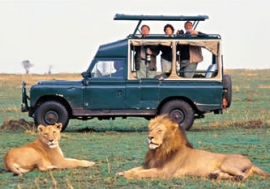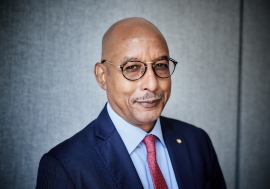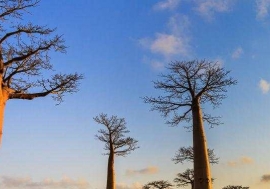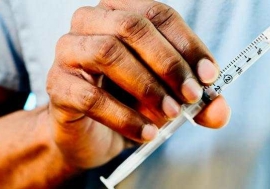Community radio: a voice for the poor
Their transmitters may reach only a few miles, but community radio stations are enabling isolated communities across Africa to voice their own concerns. On air, ordinary citizens discuss issues that are central to them, such as gender relations and combatting HIV/AIDS. They share farming tips and income generation ideas and explore ways to improve education.
“Development work at times can be like sleepwalking in fog,” Ms. Denise Gray-Felder, president of the Communication for Social Change Consortium, told Africa Renewal. “You know you’re not where you are supposed to be, and you can sense motion … but it is unclear exactly where you’re headed. A frequently missing ‘guidepost’ in development work is local voice. Community radios provide profound new opportunities for more inclusive sustainable development.” Her organization is an international nonprofit group that helps poor and marginalized communities use communications to improve their lives.
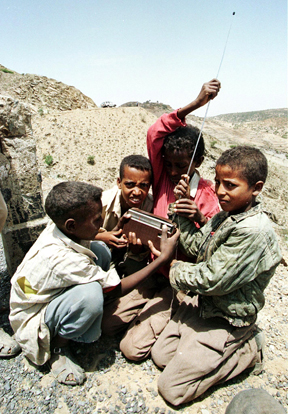 Through community radio stations, listeners in remote rural areas can hear news, practical information and the views of their neighbours.
Through community radio stations, listeners in remote rural areas can hear news, practical information and the views of their neighbours.Millions in Africa remain voiceless, despite a multitude of new information outlets. Most media remain largely state controlled. But the tide of democracy sweeping the continent has seen governments loosening their grip on the airwaves. In 1985, notes the World Association of Community Broadcasters (AMARC, by its French initials), there were fewer than 10 independent radio stations on the entire continent. Today, South Africa alone has more than 150 community stations, and other countries are catching up.
Information infrastructure
The idea of accelerating development by using both older media such as radio and newer information and communication technologies has gained momentum in Africa over the past decade. The continent’s development blueprint, the New Partnership for Africa’s Development (NEPAD), places information technologies high among its priorities. Governments agree that good Internet, telecommunications and broadcasting services can foster regional trade and improve integration into the global economy. The ability of ordinary people to communicate with each other also helps promote democracy and good governance.
The cost of setting up communications infrastructure is steep, however, especially in rural areas, where distances are vast and population densities are low. Most areas outside the major towns do not have the electricity necessary for operating land telephones or computers. Radios, by contrast, are inexpensive and can run on batteries or solar power. As a result, radio is by far the dominant mass medium in Africa. There is one radio receiver for every five people (compared with one telephone for every 100 people).
The content of radio programmes is also “cheap to create and cheap to consume,” says Ms. Grace Githaiga, executive director of EcoNews Africa. This is especially important in countries with high illiteracy rates and where many rural people speak primarily local, indigenous languages. “Neither the creators nor the consumers of radio content need to be able to read or write, due to the oral nature of the radio,” Ms. Githaiga adds.
Despite radio’s advantages, cautions Ms. Sylvia Biraahwa Nakabuku of the Uganda Media Women’s Association, the medium has some limitations. After examining the role of radio in promoting better farming methods, she concluded that people can learn only so much without physical demonstration. Radio, therefore, is best used to complement rather than substitute for agricultural extension workers.
‘The radio has changed our lives’
According to AMARC, the broadcasters’ association, community media should have a social agenda, and not be driven by purely commercial motivations. They should involve community decision-making and participation. While the impact of local radio stations varies, they often give isolated villages — many of which are not reached by public broadcasting — a means of education, self-expression and communication, while also promoting the community’s history, music and oral traditions.
“The radio has changed our lives. It makes us feel part of Mali,” says a listener in Kolondieba, a cotton-growing community in that West African country. “Before, we listened to the radios of Côte d’Ivoire. Now we can keep up to date with what is happening here. We get information on cotton farming. We can put announcements on the radio to tell our relatives about important events. We can listen to our village music.” The station, Radio Benso, has served the community since 1999 as part of the Mali-South Rural Radio Revival Project, an initiative that gave birth to four stations, each serving about a half a million people within a 100 kilometre radius.
Mali has one of the strongest community radio networks in Africa. After the fall of the last one-party regime in 1991 and the end to an outright state monopoly of the means of communications, the information media blossomed. Today, Mali has more than 110 private radio stations; 86 of them are community radios, mostly rurally based.
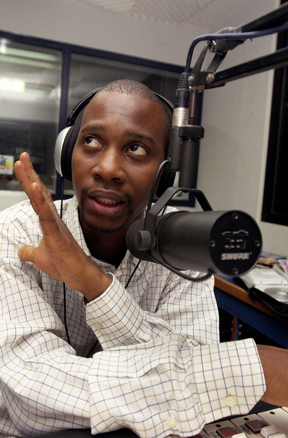 A private radio station in Senegal. Independent radio outlets help give voice to ordinary people.
A private radio station in Senegal. Independent radio outlets help give voice to ordinary people.In Zambia, a community radio project funded by the US Agency for International Development (USAID) is helping local communities adopt safer reproductive health care practices. The initiative is reaching as many as 600,000 people through a popular radio programme called “Kumuzi Kwathu” (“In Our Village”).
“Traditional birth attendants are taking more precautions because they have heard on the radio that safe practices will prevent infections during delivery,” says Mrs. Jessie Tembo, a member of a village group trained as attendants. “People are keen on learning best practices from other villages that radio is connecting us to — there is no more rushing to hospitals in the dead of night. We know how to deliver a baby safely.”
Individual empowerment
Positive change is also happening at a personal level. Radio projects bring opportunities for community members to learn new skills, thus improving prospects for employment at commercial stations. In southern Mali, local technicians, facilitators and producers, as well as board members, took a training course run by a rural radio centre in Burkina Faso. Participants learned to operate equipment, produce programmes and manage a station. International organizations such as the Agence de la Francophonie and the Panos Institute have also conducted community media workshops.
In Niger, Ms. Marie Ekaney’s daily routine was similar to that of most mothers in the village of Ingall. But working with a solar-powered radio station has boosted the confidence and social standing of this mother of five. Each week now, Ms. Ekaney spends four days interviewing local women on health and family matters and gets people to share information on income-generating activities such as traditional mat weaving. The community now holds her in high regard.
“I wanted to help develop my village,” Ms. Ekaney explained to UN Works, a website which profiles stories of people who have benefited from the organization’s efforts around the globe. “My sister and mother-in-law look after the children while I prepare my programmes and go on air.”
Funding handicap
According to AMARC, community media should not entail outsiders doing something for the community, but community members doing something for themselves. This implies owning and controlling the means of communication. But in Africa, few community radio stations are yet self-sustaining. When donor funding for a programme dries up, it usually spells the end of the project.
Exceptions do exist, especially in urban areas. The Soweto Community Radio in South Africa was set up with funding from the Communication Assistance Foundation, a Dutch organization that supports media diversity. After the two-year funding period, the station had become self-sufficient through income generated from advertisements.
Across the continent, most community radios are funded primarily by external donor countries, church organizations, international development agencies and some advertising. Stations also rely on voluntary services, leaving them perpetually struggling to develop new talent as staff members move on. AMARC President Steve Buckley notes that state subsidies of community media are the norm in Europe and North America, but largely absent in Africa.
While accepting external funding can be limiting, it does not always entail relinquishing the all critical decision-making power to the funder. The Netherlands and the UN Food and Agriculture Organization provided funding for southern Mali stations, but local people have been involved at all stages, including the project’s initial design. The villagers themselves constructed the stations’ buildings, drawing on their own resources and labour. The stations are managed by a board of directors and a committee elected by the community. The staff is hired locally.
A scarcity of funding does mean, however, that small community radios generally operate with the barest of equipment. Stations are also isolated by a shortage of transport and telephones. Cell phones are helping somewhat, but are expensive. Access to the Internet is still a dream for many in rural areas.
Despite such constraints, these stations are helping to shift the communications balance from a distant voice controlled from the top, to one in which the voices of marginalized and poor populations can at last be heard.










